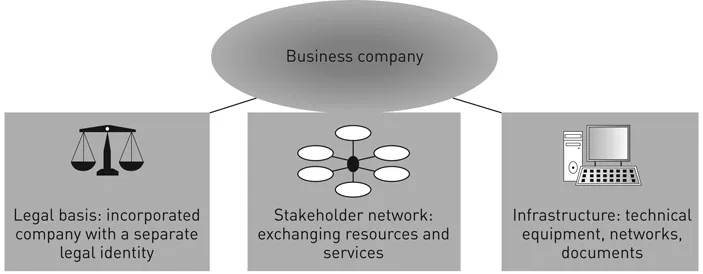![]()
Part 1
Overview
![]()
1
Purpose, structure and contents of this textbook
This textbook invites you to join in an exploration of the ways in which companies can engage in environmental management. Companies operate in markets through, for example, their customers, suppliers, managers and employees and these actors help determine whether sustainable business practices aimed at reducing environmental impacts can be successful. The following material and text should prepare you for taking the environment into account in your daily business thinking and decisions in a way that will also help you to improve your financial results.
Knowledge gained from this book will present you with the opportunity to change your thinking and the thinking of your business about environmental issues in a productive way. The book presents a way of creating value for your company, for your friends and family and for you. It does this by teaching about a future where business and individuals co-exist in a world that recognises the environmental impacts of human activities. Such recognition leads to an empathy for reducing these impacts to the absolute minimum while coming to understand that market-based businesses, guided by sound governance structures, are a necessary part of an environmentally harmonious world. Study of the book will reveal new values for your business and for you and will present you with a personal challenge, whether or not you are at present concerned about the interaction between business, individuals and the environment. While completing the book, do engage yourself with the material by:
- a Examining whether the contents reflect your own professional experience, take your own experience further or oppose your own views
- a Noting which of the ideas presented are especially important for you, add to your own ideas or encourage you to react (positively or negatively)
- a Answering questions creatively based on your own perspective of the issues
- a Encouraging yourself to be inspired by questions, which can be investigated further through other written sources of information on an issue, through the Internet by using keywords for searching on a topic, in conversations with acquaintances or by considering comments in the media (television, press, radio, etc.)
- Relating to others who are studying with this book and to the authors if there are matters that you would like to see added to this book or information about further sources that you consider useful in developing your knowledge in this area
- Thinking about and planning the ways in which you can use and implement in your own situation what you have learned
The text makes clear what an environmental orientation is, why it is good for business management to adopt such an orientation and the range of themes within such an orientation that are examined here. It makes things clear by using a four-part structure (see the figures on pages 7, 53, 171 and 205).
The first part of this book briefly but clearly sketches the fundamental ideas and linkages behind business management, the environment and sustainable development. The second part outlines the criteria against which environmentally oriented business management can be assessed and the fields of action in which success can be achieved. After this, the third part presents a discussion and examples of strategies for environmental management, which are linked, in the fourth part, to important tools of environmental management, especially eco-marketing, environmental accounting and eco-control. Also, the book is illustrated with a range of case studies and examples related to the main contents of each chapter.
Although you can begin the book at the first chapter and work through until the end of the final chapter, you may wish to move about the contents of the book in a flexible way, especially if you want to follow up on a particular topic at the time it is introduced. The materials are designed to be used for understanding and reference rather than to be learned by heart. The main aim is for you to obtain a practical understanding of the relationship between management and environmental issues. The text is supplemented with numerous figures, references, Internet site addresses and boxes. Boxes provide examples, definitions or additional information about issues explained in the main text. Comments about useful literature are also included, to help if you wish to read further about a particular issue. Several pieces of literature are recommended as background to this course on environmental management and a number of useful websites are also listed to help you get a quick lead in to the subject.
Recommended reading
Schaltegger, S., and R.L. Burritt (2000) Contemporary Environmental Accounting: Issues, Concepts and Practice (Sheffield, UK: Greenleaf Publishing).
Welford, R., and A. Gouldson (1993) Environmental Management and Business Strategy (London: Pitman).
Recommended websites
The Australian National University, Canberra, Australia
anulib.anu.edu.au/elibrary/search.html
BSR (Business for Social Responsibility)
www.bsr.org
Centre for Sustainability Management, University of Lüneburg, Germany
www.uni-lueneburg.de/csm
Environmental Defense
www.scorecard.org
Environmental News Network
enn.com
Greenbiz: The Resource Center on Business, the Environment and the Bottom Line
greenbiz.com
International Organisation for Standardisation
iso14000.net
Natural Resources Defense Council
www.nrdc.org
OneWorld
www.oneworld.net
Pew Center on Global Climate Change
www.pewclimate.org
Pollution Online
pollutiononline.com
Social Investment Forum
socialinvest.org
Sustainable Development Communications Network
sdgateway.net
WorkingForChange
workingforchange.com
Question for review
- 1.1 What are the four main sections in this book? Why do you think that each section is important for an understanding of environmental management by business?
![]()
2
Management and business companies
There are numerous definitions of ‘management’ in a business context—but, most of the time, these are not satisfactory, because they define the concept of management with use of words that also need to be explained. This means that a simple understanding of what management involves is not usually conveyed. Typical would be a definition that management involves ‘reduction of uncertainty’, ‘leadership’ or ‘motivation’, without an explanation of these terms being given (see Neuberger 1994: 5). To avoid this problem in defining management, in this book an analytical path is provided to help with your understanding of the meaning of management (see Fig. 2.1).
Figure 2.1 Subjects and objects of management
Management presupposes two things: a subject that manages (e.g. a single manager of a small business company) and an ‘object’ that is to be managed (e.g. the whole business company). ‘Management’ is often used instead of the word ‘manager’. When the word ‘management’ is used it refers to one of two aspects of the subject that manages. Either it refers to the role of managers—what managers do that is different from what others (e.g. employees) do—or it refers to the function of managers—what the specific activities of managers are.
The role of managers is closely related to the powers that are conferred on different levels of management—top-level, middle-level and lower-level management. Even top managers have limited powers and they practise management within the constraints set down for companies by the government within the current political framework. The function of managers can be divided into formal and informal aspects. Formal functions are established in contracts and job descriptions (e.g. for a product manager, finance manager or production manager). Informal functions of managers are related to the personal style, influence and charisma of each manager—the way a manager interacts with other people. Distribution of management roles and functions in each company depends on the extent to which each employee is capable of solving problems (see Probst 1993). If an employee has high capabilities and strong personal motivation to work in the interests of the company, then there is less reason for management oversight. The object of management can be a person or group of people, including lower-level managers, or objects with which the company is involved (e.g. buildings, machinery, materials, products, services or abstract objects such as company reputation).
Management can relate to many types of organisation such as a business company, a household or a government. In this textbook the focus is on management of a business company—including the formal and informal functions mentioned above. The business company is defined as being a separate legal entity that has, as its main purpose, the creation and distribution of economic wealth. It provides an independent legal basis for transacting in the marketplace and the technical infrastructure for producing and delivering goods and services to consumers. Most business companies involve people and are also, therefore, social entities. As social entities business companies can be viewed as consisting of a network of stakeholders that supply resources to the business and receive services from the business (see Fig. 2.2).
Figure 2.2 Aspects of the business company
Stakeholders are defined to include every individual, or group, that has a claim on the company (Freeman 1984: 25). Usually, the claim arises through an exchange relationship whereby the stakeholder provides resources, and goods, or services, are received in return. Such exchange most often involves an economic settlement between the parties, but the company is also involved in social exchange and exchange with the physical environment in which it operates. In all cases, stakeholders rely on the company in order to attain their own economic, social or environmental goals. Likewise, in order to achieve its goals and increase its economic wealth the business relies on resources provided by its stakeholders. Interactions between the business and its stakeholders are guided by rules, routines, established procedures, common standards, negotiations, debates and use of power. Each company uses some or all of these mechanisms in different combinations to achieve its purposes. Different combinations of mechanisms distinguish one company from another.
Management, through its interaction with various stakeholders, is responsible for company direction, change and development, for putting in place technical processes and procedures, for securing finance for company investment and operations and for getting people to work with each other towards the company goals—a position of goal congruency. Management influence and credibility depends on its ability to balance relationships with each group of stakeholders while focusing attention on specific stakeholder problems as they arise.
Five fundamental ideas are useful for understanding the processes of management. Management implies:
- Dynamics
- Orientation
- Freedom of action
- Power
- Responsibility and accountability
2.1 Dynamics of management and leadership
Management is a dynamic process. The situations that managers face involve constant change. The challenge is for managers to try to ensure that the companies they manage can adapt to changes when these occur. Management determines the direction that companies will take when they need to adapt. Such direction is often summed up with use of the word ‘leadership’. In etymological terms, the word ‘leader’ (conductor) is derived from the word ‘lead’ (to be in front) and describes the process of getting and keeping the company on the right track towards achieving its goals (see Drosdowski 1998). Hence, management is a dynamic process oriented towards adaptation of people (stakeholders) associated with business in order that business, individual and group goals can be achieved. Management leads the business towards its goals and keeps it on course, or ‘steers’ it towards its goals, as expected and unexpected changes occur. This process is referred to as ‘steers-manship’.
2.2 Orientation of management
Management is oriented towards achieving the goals established for the business company. Managers have their own goals, but the main reason for their employment is to achieve the goals of company stakeholders. If a single manager is the owner of a small company, the aims of the manager and the owner will be identical and will determine the business goals. In a large or medium-sized business, owners also maintain a strong claim t...


